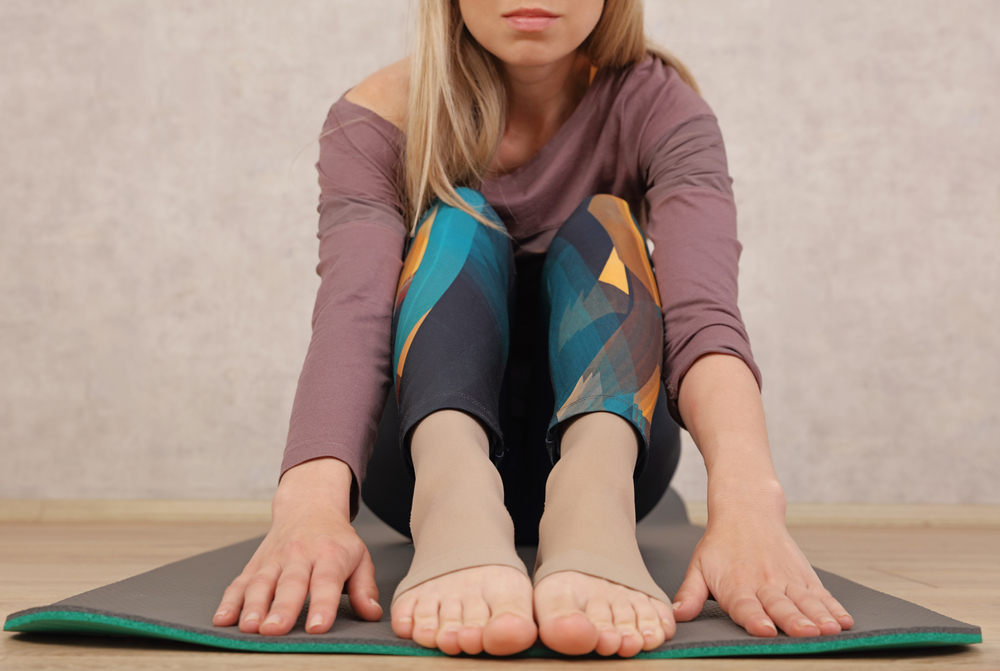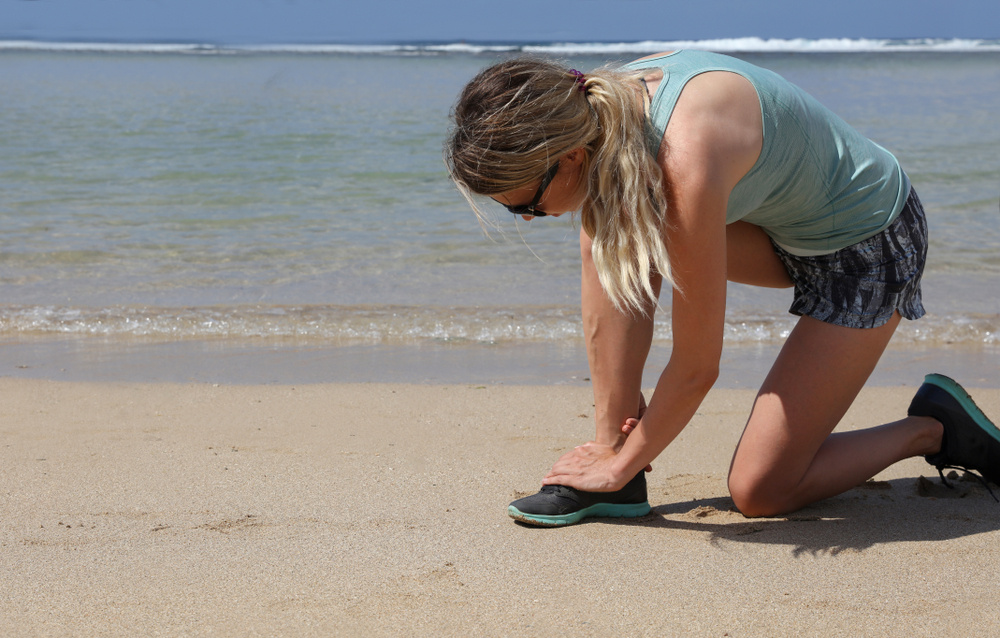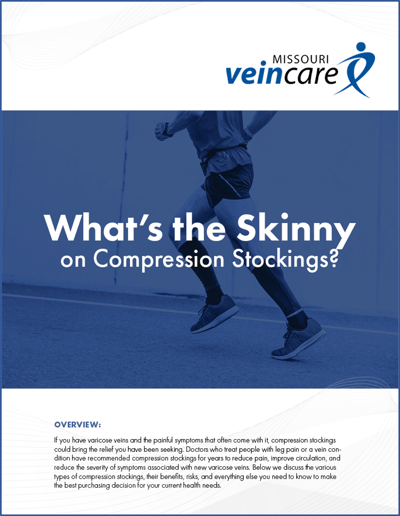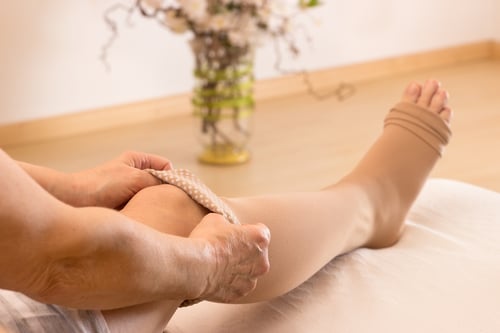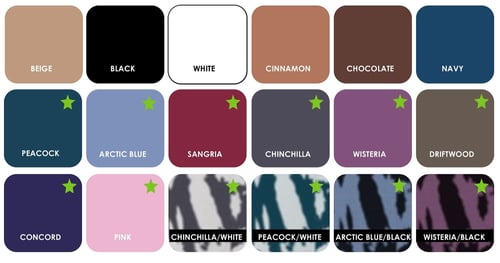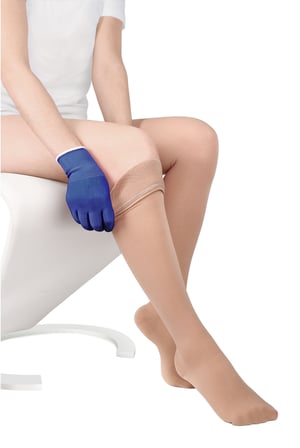- Will they work?
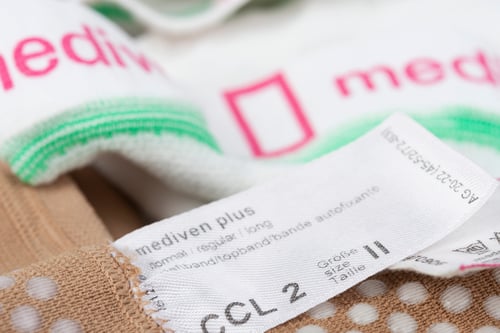
- Why do they work?
- How do I get the right fit?
- Is there a trick to putting them on?
- How long do I wear them?
The reality is that most people don't really like to wear them. They can be hot and uncomfortable and, honestly, a bit of a hassle. However, people will also tell you that simply wearing compression stockings has been a major step in managing their health. By choosing to wear compression stockings, people who have a vein condition are able to be active again and do the activities they used to do. They can live, work and move without exhaustion, fatigue, leg pain, and swelling. Additionally, those who enjoy traveling say that they are able to remain seated for extended periods of time without worrying about developing a blood clot...all because they made the choice to wear compression stockings.
For people who deal with leg problems due to a vein circulation condition, wearing compression stockings can greatly reduce symptoms. The most common symptoms of a vein condition are aching and uncomfortable legs and an overall feeling of fatigue. These symptoms are worse at the end of the day and are the result of inflammation buildup due to stagnant blood flow.
Perhaps you have hesitated to invest in compression stockings because you fear they will be unattractive, difficult to wear, or expensive. Although there is some truth to these concerns, the reality is that wearing compression stockings daily offers several benefits you cannot get from any other type of treatment for your vein condition.
On this page, we talk about everything you need to know to successfully wear compression stockings. Scroll down to review them all or simply click on the topic below to go right to that section.
1. How and Why Compression Stockings Work
2. Different Types of Medical Hosiery
3. Compression Stockings and Athletic Performance
4. Different Types of Compression Stockings
5. How to Select the Right One for You
6. Measure for getting the correct fit of compression stockings
7. 5 Tips for putting them on:
- Wearing rubber gloves
- The inverted stocking method
- The plastic bag method
- Stocking over socks method
- The stocking butler method
8. How to take them off easily at the end of the day.
9. Alternatives to Compression Stockings
In spite of their drawbacks, the wearing of compression stockings is an important part of diagnosing and treating a vein condition. For many people, they are a lifesaver. The benefits far outweigh the costs.
In this short video, I explain the benefits of compression stockings and why so many people are wearing them:
We agree that, in a perfect world, nobody would have to wear compression stockings. They are a pain to put on and take off, they can be uncomfortable under clothing, and in the summer they can be hot. However, for people who have a vein circulation problem, compression stockings really make a significant difference. They really do help.
Insurance Companies Often Require a Compression Stocking Trial
Most insurance companies require a trial period, usually anywhere from 6 weeks to 3 months depending on the plan, where they will require you to wear compression stockings before they will approve vein treatments. During the compression trial, you'll notice whether or not they make a difference in alleviating the symptoms you've been experiencing. Be sure to check with your insurance provider for the right details in your plan. When your symptoms are the result of a vein condition, compression stockings will relieve the symptoms but know that compression stockings are not a permanent fix.
Why Are Compression Stockings Needed?
Compression stockings help improve circulation when a vein condition is present. They work to alleviate the corresponding symptoms.
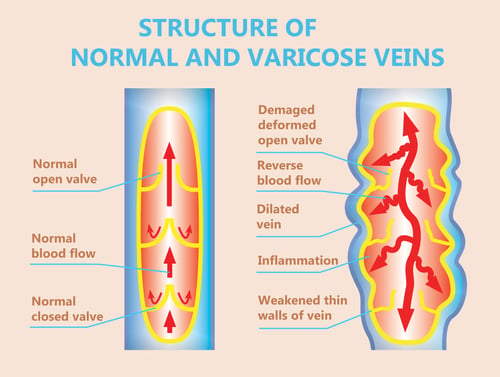 What is a vein condition?
What is a vein condition?
With a vein condition, there are valves in the veins that prevent the backflow of blood in the lower legs as the heart pumps it back up the body to the heart. With a vein condition, these valves weaken and as a result, blood pools in the lower legs. The result can be both visible and invisible. It's important to note that not all people with a vein condition experience the visible signs: spider veins, bulging veins, skin staining, and even the presence of a skin ulcer. Most people who suffer from a vein condition have no visible signs at all...but the invisible signs can be debilitating. Invisible signs include fatigue, exhaustion (even after a good night's sleep), leg aching and pain, lower leg swelling, and an inability to remain active or participate in normal life events. Another common indicator of a vein condition is that these symptoms always worsen at night.
How do Compression Stockings Work?
Compression stockings work by applying pressure to your ankles and legs, helping the stretched-out vein valves to work better. When the valves are working better, the flow of blood from your legs to your heart= returns to normal, and blood no longer pools in your legs. The stagnant blood is the cause of fatigue and leg pain and swelling, so when blood flow is restored, symptoms improve. When you notice an improvement when wearing compression stockings, it’s a pretty solid indicator that a vein treatment will help even more to increase your energy and reduce symptoms.
One of the first things you may notice after you start wearing compression stockings regularly is that you have more energy and feel less tired. That is because the socks reduce the inflammation in your legs responsible for causing fatigue - scientists have even measured this in the bloodstream. You will also notice a decrease in leg symptoms including aching, restless legs, cramps, heaviness, and pain. The benefit can be mild, but for many patients, it is worth wearing the stockings to get some relief.
Keep in mind that the purpose of compression stockings is to help make people feel better by reducing symptoms. They cannot prevent you from developing a vein condition or make it go away. You may even find that your symptoms return immediately when you take your compression stockings off to go to bed at night. This is normal. You can put them on again in the morning after you take your shower.
Additional Benefits of Wearing Compression Stockings
- Prevent blood clots during extended periods of sitting at home, at work, or while traveling.
- Help to prevent the development of venous skin ulcers.
- Improves overall circulation and energy level.
- Can improve performance at work.
- Improves sleep for those with vein-related sleep disturbance.
- Provides important support to the veins and improves vein valve function.
- Reduces blood pooling or clotting in the legs and lowers the risk of DVT blood clots.
- Reduces the leg pain, cramps, swelling, fatigue, and restless legs
What's the Difference Between Various Types of Medical Compression Hosiery?
Medical hosiery can serve a variety of purposes, from providing support and comfort to aiding in the prevention and treatment of medical conditions. However, with so many different types of hosiery available, it can be challenging to determine which one is the best fit for your needs. That's why we've created this infographic to help you understand the differences between three of the most common types of medical hosiery: compression stockings, support hose, and TED stockings. By examining the unique features and benefits of each type, you'll be able to make an informed decision about which type of hosiery is right for you. Whether you're dealing with a medical condition or simply looking for additional support and comfort, understanding the differences between these three types of medical hosiery can help you find the perfect fit.
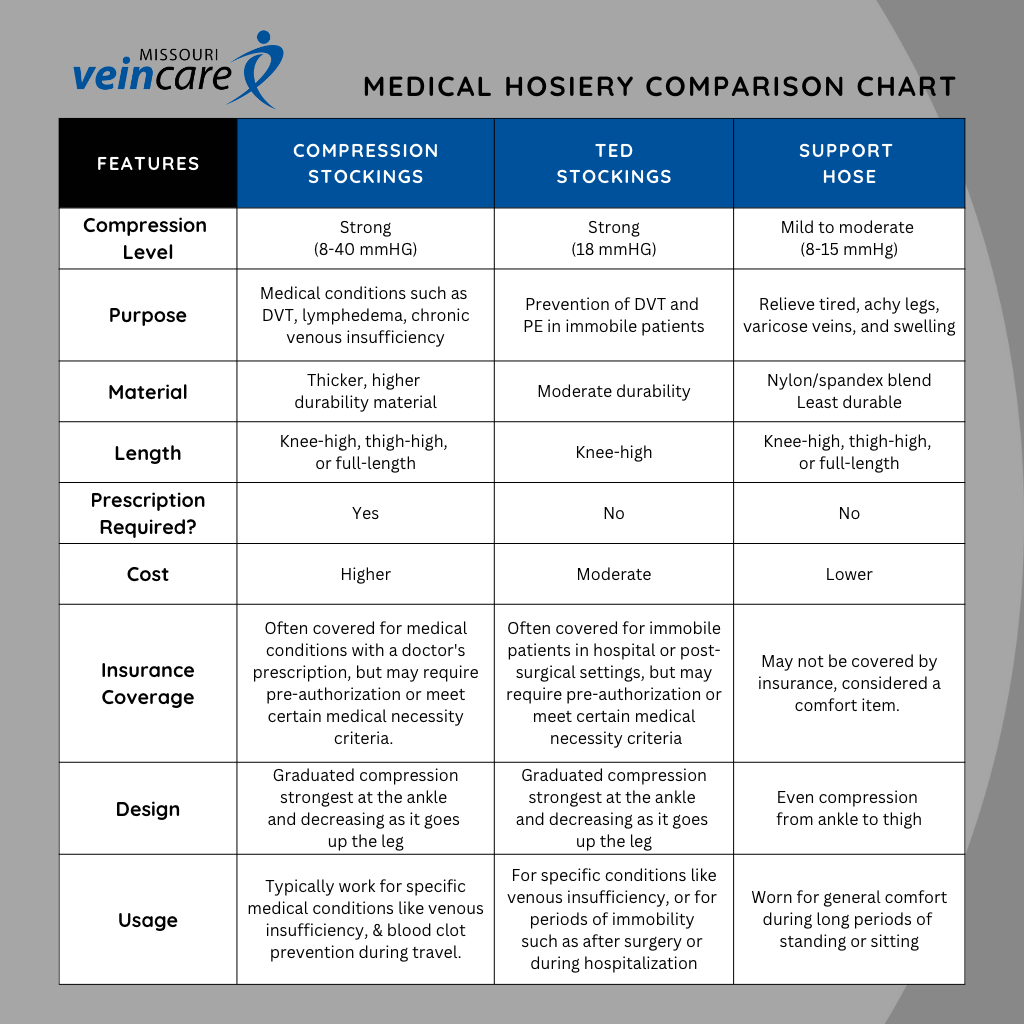
How Can a Vein Condition Affect Athletic Performance?
If you are an athlete, can the presence of a vein condition affect your performance? Absolutely.
A Vein Condition Affects You Physically:
Fatigue, inflammation, and painful, swollen legs are common side effects of a vein condition and will definitely affect your performance. The challenge is that most athletes are able to put up with the symptoms longer and think it’s a side-effect of athletic conditioning - not realizing it's actually a treatable condition that can improve their performance.
A Vein Condition Affects You Mentally:
The key to athletic conditioning is mental and emotional toughness. Inflammation affects both. Inflammation molecules affect the emotional state and the ability to concentrate. Because of inflammation's effect on the body's energy output, you have a psychological effect because you can no longer perform at the same level. That can be devastating for a performance athlete. When physical activity is impeded by pain or discomfort, your body wants to avoid those activities. Many people may no longer enjoy the sport that they once loved because of the physical toll, and decide to quit exercising altogether.
Athletes we’ve treated, both young and old, all describe feeling fatigued which affects their athletic performance or training. The fatigue associated with a vein condition isn’t normal...it is a very specific characteristic of a vein condition in that it's worse in the evenings and leaves even the most active individuals searching for a recliner or someplace to elevate their legs. They feel worn out in the evening and just can’t move without a big effort.
For a complete description of what to watch for, we have two free downloadable resources that will be helpful:
Will Compression Stockings Improve An Athlete's Performance?
It's no secret that regular exercise improves the symptoms of a vein condition, but does the reverse work: can the use of compression stockings improve exercise performance? Compression stockings are gaining popularity, especially with runners. Evidence suggests that—when compression stockings are worn relatively tightly and for a minimum of a few hours after a workout—they can aid in muscle recovery, minimizing pain, and restoring blood flow. To know if this works for you, you will have to give it a try. If you have some soreness normally after a workout, see if the stockings reduce this and you will have your answer.
Compression stockings support the lymphatic and venous systems in the legs, helping muscles rid themselves of the lactic acid which builds up during and after a rigorous workout. They may also offer limited stability and protection for the joints, as the compression provides a layer of additional support.
While it is clear that stockings help people with vein conditions with athletic performance, there is no evidence to suggest that compression stockings improve athletic performance for people with normal veins. With that said, many athletes swear by them, claiming that the recovery benefits and reduction of calf strain make them well-worth wearing. Plus, except for the time it takes to put them on, there are few adverse effects reported, mostly related to stockings that are too small causing numbness.
The choice of whether or not to use compression stockings remains a personal one. If you have leg fatigue and soreness in your calves, knee-high stockings are all you need. If you have thigh soreness after exercise, you should try thigh-high or pantyhose style. Thigh-highs work well when exercising if you wear exercise tights over them to prevent them from slipping down. If you notice a difference when wearing them, you will have your answer.
Free Ebook: What's the Skinny on Compression Stockings?
I hear lots of questions every day about compression stockings. Why does my insurance company require me to wear them? Do they really work? What are the different types? How do I find the right size? Can you help me put them on? Do I have to use compression stockings or will ace bandages work? Those questions, and more, are what inspired our latest eBook: “What’s the Skinny on Compression Stockings?” Designed to answer those questions and more, this eBook is an excellent resource for anyone who has been or is considering wearing compression stockings.
This eBook “What’s the Skinny on Compression Stockings” will give you the information you need to make the best decisions possible for your own healthcare. For your free copy, fill out the form below.
Some of the most common questions we get from patients are about what exactly they do for the leg that helps alleviate the symptoms of a vein condition, namely: swelling, aching, fatigue, and even restless leg syndrome. There are many different types of compression stockings, so it's helpful to understand your choices before making a purchase.
What Types of Compression Stockings Are There?
When it comes to compression stockings, there are a few factors to take into consideration, like finding the most comfortable pair... which is the key to using them. The main issues preventing comfort are: toe-less or not, the length (knee high, thigh high, pantyhose), compression strength, tightly fitted, and type of material. Finding a pair that meets your needs on these key parameters will allow you to reap the full benefits of compression stockings. This guide is based off what I have observed with patients over the years to help you figure out which ones are the right fit for you! With so many stocking options, doing your own research on line and reading reviews is crucial to picking the right one based on what your comfort needs are.
Toeless vs. Toe-in
Most patients do fine with standard (toes covered) stockings. If you have known issues with bunions, tender calluses, large toenails, sensitive or painful toes or feet, and numbness in your toes - then toeless will likely be the best choice. Some patients say the feeling of the toeless stockings on their feet takes a little adjusting, just like a new pair of shoes! Patients also like to wear toeless stockings in the summer so they can wear sandals. People with large feet often prefer toeless due to comfort.
The Length
Most people do very well with knee-high stockings as they are the easiest to wear and the length we commonly recommend. Make sure the knee-high stockings are long enough to make it below the knee joint; if not they will slip down. Patients who benefit from thigh-high stockings usually have bulging painful veins in their thighs or have tried the knee-high, but find they dig in at the knee. Thigh-high stockings can slide down, but this can be prevented by the use of silicone lotion which is very patient-friendly. A garter belt and the use of tight-fitting shorts can help as well. For pregnant women or people who are overweight that need thigh-high stockings, a pregnancy pantyhose style can work much better to avoid sliding down.
Additional Factors to Consider When Selecting the Right Compression Stockings:
- Compression Strength: In general, the higher the compression, the harder it is to put on and take off and the greater the chance the stockings may damage skin nerves. I recommend 20-30mmHg which is a good middle-of-the-road option is well tolerated, is great for providing support, and meets most insurance requirements. If you are not concerned about meeting insurance requirements, you can also try 10-15 mmHg but you may not get much relief. The higher strength (30-40 and 40-50 mmHg) can cause skin nerve injury and lead to numbness, and I recommend these only for advanced vein conditions such as post-thrombotic syndrome after a DVT or a skin ulcer.
- Appearance: Sheer material often looks nicer and has a dressier, thinner look. The look of the stocking and the pattern is wide open - this is no longer about your Grandmother's compression stockings - there is a wide selection of colors and patterns available.
- Skin comfort: Comfort depends to a large extent on how your skin tolerates the various polyester materials and cotton. If you know what you don’t tolerate well, cross-reference when you shop for stockings. There are also 100% cotton compression stockings that allow your skin to breathe well.
- Heat tolerance: Depends on the density of the weave, the thickness, and the type of material. Wider weaves and thin stockings with more cotton have fewer complaints about being hot. Thinner stockings, while usually not as hot, are not as sturdy and tear more easily when putting them on so be careful.
- Ease of use: Wider weaves and thicker stockings are easier to grab with your fingers to put on or take off. For the people intolerant of thinner stockings, this will have less heat build-up.
Comfortably Wearing Compression Stockings:
Stockings work best when worn all day from first in the morning until sleep at night. It is not normally recommended to wear them while you sleep since the compression can cause damage to the skin nerves resulting in numbness and tingling.
Before you buy your first pair of compression stockings, we recommend that you measure your leg to ensure you get the proper fit. A pharmacy, family member, a friend, or your healthcare provider can do this. The distance around your leg is measured below the knee and at the ankle with a string or tape measure and compared with a sizing chart. In our experience, if you buy or borrow stockings that are too small, it causes a great deal of pain and can lead to skin nerve damage (numbness and tingling). If the borrowed stockings are too big they won’t work very effectively.
In this section, we will give you a step-by-step guide - as well as a video demonstration - of how to measure for the right fit, put them on, and take them off.
Scroll down to review them all or simply click on the topic below to go right to that section.
1. Measure for getting the correct fit of compression stockings
2. 5 Tips for putting them on:
- Wearing rubber gloves
- The inverted stocking method
- The plastic bag method
- Stocking over socks method
- The stocking butler method
3. How to take them off easily at the end of the day.
Getting the Right Fit.
It's important to get the right fit for your compression stockings. They should not be painful to wear, and the right compression strength is needed to ensure optimal results. Proper fit = proper results.
Our team will help you measure correctly in the office and give you the correct compression strength, but in case you want to purchase your own at a pharmacy, here are proper measuring techniques.
In the video at the right, our team demonstrates proper measuring techniques.
In this video, our staff demonstrates how to take proper measurements to get the right fit.
 Take your measurements in the morning when your swelling is minimal for a more accurate reading and measure the leg that tends to swell the most. Also, if you don't have a flexible tape measure at home, you can use a piece of string to mark the appropriate length, and then lay the string along a yardstick to record the actual measurement. It's important for any of these readings to be as accurate as possible, so we suggest having a partner assist you.
Take your measurements in the morning when your swelling is minimal for a more accurate reading and measure the leg that tends to swell the most. Also, if you don't have a flexible tape measure at home, you can use a piece of string to mark the appropriate length, and then lay the string along a yardstick to record the actual measurement. It's important for any of these readings to be as accurate as possible, so we suggest having a partner assist you.
Measuring For Knee-High Compression Stockings
These 3 measurements are taken sitting down:
1. For the first measurement is the distance around your ankle, just above the ankle bone.
2. The second measurement is the width of the calf muscle at the widest part.
3. Lastly, the third and final length is a vertical measurement from the floor to one finger length below the bend in your knee.
Measuring For Thigh-High Compression Stockings
There are 4 measurements total - the first two measurements you'll take sitting down, and for the last two, you'll stand up:
1. For the first measurement is the distance around your ankle, just above the ankle bone.
2. The second measurement is the width of the calf muscle at the widest part.
3. Standing, the third measurement is the distance around your upper thigh, three-finger lengths below your buttocks.
4. The fourth and final measurement is the distance from the floor to three-finger length below your buttocks.
Compression stockings should be tightly snug, but not so tight as to cut off circulation or cause pain - that would completely defeat the purpose!
0ur trained office staff and nurses will help you get the correct stockings the first time
Our first suggestion, given their tightness and your need for grip strength, is to wear rubber gloves. Many of our patients find that wearing rubber house-cleaning gloves or surgical gloves makes it easier to grip the stockings and pull them on. If you are having trouble with the hand strength required to pull them on, you may want to this technique.
We explain and demonstrate how to put your compression stockings on using rubber gloves in this video below;
In this video, our staff demonstrates how to put compression stockings on with the help of rubber gloves.
Tip #2: The Inverted Stocking Method
The Inverted Stocking Method can be done with either open or closed-toe stockings and is the process of turning the sock inside out until the heel of the sock is exposed. From there, it becomes easier to slide your foot and heel into the stocking, pulling a smaller portion of the stocking over your heel, and then sliding the rest of the stocking up your leg.
In this video, our staff demonstrates how to put compression stockings on using the inverted stocking method.
Here's a step-by-step overview:
-
Put your hand inside the stocking, grab hold of the heel, and slowly begin to turn your stocking inside-out. You’ll do so until the heel of the stocking appears in your hand.
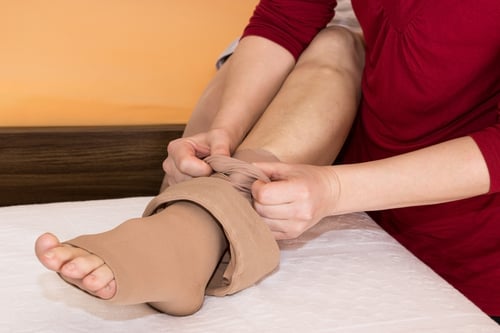
-
Next, you can either sit down or lay down. Flexing your foot, open up the mouth of the stocking, and insert your toes into the stocking pulling it over your heel.
-
Now that it’s over the foot near the heel, pinch and pull...little by little...slowly working the stocking up. Make sure there aren’t any creases and that the stocking is smooth. Creases will increase pressure on a thin area and can cause discomfort.
-
If your stocking is thigh-high, once you have the stocking at knee level, stand to pull the stocking the rest of the way up.
-
Double-check and make sure the stocking is smooth without any creases.
-
Make sure the heel of the stocking is over the heel to avoid pinching on your feet.
Tip #3: Plastic bag method
Since the heel of your foot can be troublesome in getting compression stockings to easily slide over it, the next few tips offer suggestions for maneuvering that problem area. This top involves using a plastic bag and can be done with any plastic bag. Our demonstration video uses a Ziploc bag, but you can also use a grocery store bag - whatever you have on hand. The plastic provides a slick surface for the stocking to slide over. Keep in mind, these tips are only for open-toe stockings...as you have to be able to remove the bag once the stocking is on your foot.
Here's the step-by-step:
- Place a plastic bag over your foot and above your ankle; the bag should be just large enough to cover both the foot and ankle.
- Pull the stockings on over the plastic bag, as it will slide smoothly into place.
- Adjust the stocking height so that the heel of the stocking matches your heel.
- Peel up the stocking back over the toes and ankle enough to allow the bag to be pulled out.
- Then pull the stocking back over the foot and ankle and adjust, making sure there are no creases.
- Depending on how long your compression stockings are, you can pull the stocking up to your knee, and then stand to pull it the rest of the way up your leg if it's thigh-high.
In this video, our staff demonstrates how to put compression stockings on using the plastic bag method.
Tip #4: Stocking Over Socks Method
Some people find it easier to slide compression stockings over a sock than over bare skin. If you choose this method, be sure to select thin anklet socks, as the compression could cause pinching with thick socks or socks that extend up onto your calf. The goal is simply to make it easier to get the compression stocking on your foot. The video here demonstrates how to successfully use the sock technique.
Here's the step-by-step:
- This method can be done with either open or closed-toe stockings. Just know that with closed-toe stockings, you'll ultimately have two pairs of stockings on your feet, so select thin socks.
- Put on a thin polyester sock to cover above the ankle, or choose a thin anklet sock, being sure to leave some space over the toes since the stocking tends to move it up and pull it a little tighter.
- Pull the stocking on over the sock. The presence of the sock provides a smoother so that it slides more easily over your foot and heel.
- Be sure to adjust both stockings to match heel to heel.
- With toeless compression stockings, be sure to adjust your sock if needed to avoid any pinching on the toes.
In this video, our staff demonstrates how to put compression stockings on with the stocking-over-sock method.
Tip #5: Stocking Butler Method
The stocking butler is an amazing little tool that makes the process work easily, providing assistance not just in helping get the stocking over your foot and heel, but also in pulling it up and into place on your leg. You can find stocking butlers and most pharmacies and general merchandise stores like Walmart or online in a range of price options. Stocking butlers can also be used easily with either open or closed-toe stockings. They are an excellent solution if you have a poor hand or grip strength.
Here is a step-by-step process for using a stocking butler:
- Sit down in a chair and place the stocking butler so that the inner section, with the outside handles on the right and left, and the inner section - shaped like a "C" - with the open part of the C facing away from you. For reference, your foot will eventually slide down into the middle section and your heel will sit against the back part of the "C."
- Lay the compression stocking, foot down in the inner part of the "C," pulling it down over the outside so that the stocking is inside-out. Keep pulling it down until the heel is exposed and is even with the top back of the middle of the butler.
- Insert your foot down into the middle of the stocking until your heel matches the placement of the heel on the butler.
- Grabbing the two taller handles on either side, slowly pull the entire stocking butler up your leg. If you are wearing thigh-high stockings, you'll want to stand and pull the stocking past your knee on up your leg until it's in place and crease-free.
In this video, our staff demonstrates how to put compression stockings on using a stocking butler or donner.

Bottom line, compression stockings should alleviate pain, not cause it.
Monitor your stockings for comfort in the first few days you wear them. If they are pinching especially over your toes, feet, shin, ankles, or knees, they may be too small or pulled up too high. Discuss any problems you may be having, as your vein care specialist will want to make sure you have the correct size and fit. Then, provided you’ve measured properly, they will fit snugly, but not pinch or cut off circulation.
Taking Off Compression Stockings Quickly and Easily.
If they are stockings with higher compression or if it's in the heat of the summer, it can be even more difficult. That's why we've assembled tips for helping you remove them easily.
Here is a step-by-step process for removing your compression stockings:
1. If you have trouble with hand strength, we suggest using rubber kitchen gloves or a pair of surgical gloves. They grip the stockings more easily and help prevent tears in the stockings because of fingernails.
2. Sitting down, be sure to grab ahold of them where the fabric is below the top band. Be careful not to grab them by the top band, as pulling on the band can cause the fabric to tear away and the stocking to rip. Make sure you have ahold of the fabric.
3. Once you have a grip on the sock, think about peeling a banana. Slowly fold the stocking down your leg, a little at a time. Once you reach your ankle, you should be able to slip it over your heel and off your foot.
In this video, our staff demonstrates how to quickly and easily remove compression stockings at the end of the day.
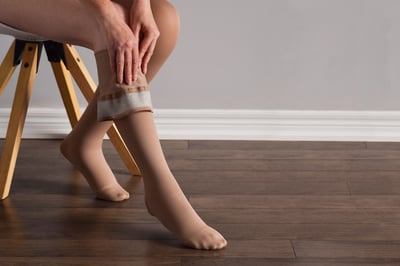
What Are Alternatives to Compression Stockings?
Compression stockings are a great option for many people, but there are those who for a variety of reasons, are unable to wear them. For individuals with arthritis or who lack the grip strength to be able to pull them on, or for people who do not have the ability to bend over and reach their toes, compression stockings can be problematic if not impossible to wear. What options exist when you need the compression strength but are unable to get them on by yourself?
1. Tubigrip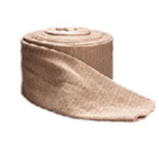
Tubigrip is a tubular bandage that is worn over the legs to provide compression. It is made of a stretchy material that can be easily pulled over the feet and up the legs, without the need for fastenings or straps. Tubigrip is available in a range of sizes and can be worn alone or over other hosiery.
2. Circaid Compression Wrap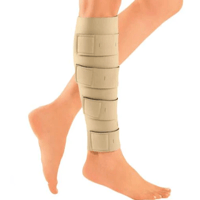
Circaid Compression Wraps are designed to provide adjustable and comfortable compression. This wrap can be adjusted to fit the individual's needs. The wrap can be taken off and put on easily, and for that reason is a great solution if there is a skin sore or wound. Circaid Compression Wraps provide compression to the legs while allowing for mobility.
3. Double Support Stockings
For those who struggle with putting on traditional compression stockings, simple support stockings are much easier to maneuver. They provide compression support and are available in various styles and sizes to fit the individual's needs. Simply put on 2 pairs, one on top of the other. This will provide the needed compression strength while making them easier to take on and off.
It's important to note that these options may not provide the same compression level as traditional stockings. However, they can still provide significant benefits for individuals who struggle with strength or flexibility issues. If you're unsure which option is best for you, speaking with your healthcare provider is always a good idea. They can help you determine which type of compression stocking or hosiery is right for you based on your individual needs and medical condition.
Still Have Questions or Need Assistance with Compression Stockings?
If you are considering stockings, contact our office. We have a team who can answer your questions. If you are having symptoms of a vein condition, we encourage you to schedule a vein screening. In your free vein screening, our team will look at your legs and ask you a series of questions designed to uncover patterns that indicate the likely presence of a vein condition. From there, if we determine there is a need, we will help you schedule a specialized vein ultrasound and recommend next steps.
Did you find this information valuable?
Check out our blog for more great information! We also have free resources, Ebooks and checklists designed to address questions and concerns we hear most often. Subscribe to our blog to get updates on the latest posts. Don't hesitate to share this information with a friend or family member.


